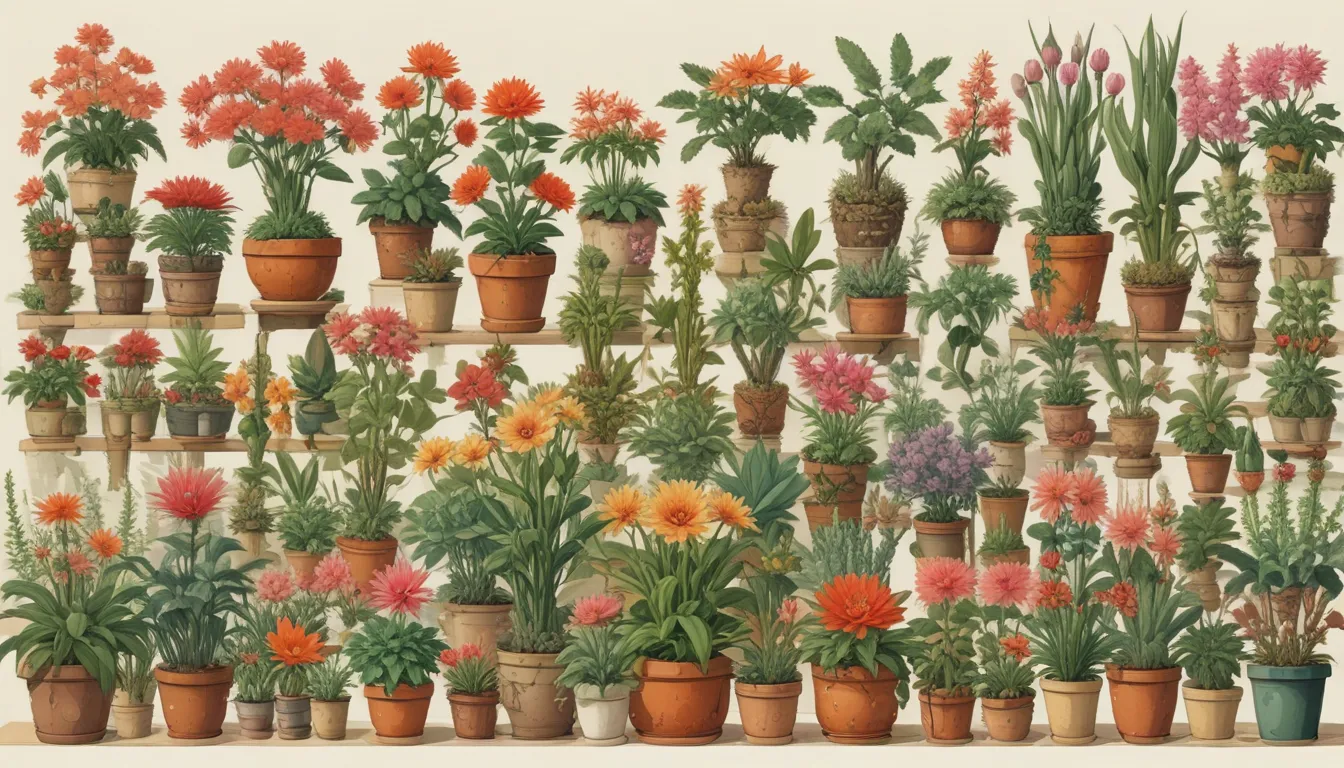Epiphyllums: A Guide to 23 Varieties for Your Home Garden

Epiphyllums, also known as orchid cacti, are fascinating plants with long, flat stems and stunning blooms. Whether you’re a beginner looking to explore new plant varieties or a seasoned collector of these beautiful cacti, there’s a wide array of species and hybrids to choose from.
In this comprehensive guide, we’ll introduce you to 23 fabulous types of epiphyllums. From the classic favorites to some lesser-known gems, we’ll cover everything you need to know about these captivating plants.
So let’s dive in and explore the wonderful world of epiphyllums:
Understanding Epiphyllums: A Closer Look
Before we delve into our selection of epiphyllums, let’s take a moment to understand the unique characteristics of these plants. Epiphyllums belong to the Cactaceae family and the Hylocereeae tribe, and they are known for their large, showy blooms.
While the genus Epiphyllum includes several species, some plants that were once classified within this genus have been reclassified under other genera, such as Selenicereus or Disocactus. Despite the scientific name changes, these plants are still commonly referred to as epiphyllums by collectors and enthusiasts.
Aside from species plants, there are also hybrid epiphyllum cultivars bred for their vibrant colors and striking flowers. These hybrids may have Epiphyllum ancestry or be a cross of different genera, but they are popular among epiphyllum fans for their impressive blooms.
Now that we have a better understanding of the diverse range of epiphyllum plants, let’s explore 23 of the most fabulous varieties you can consider for your home garden:
1. Ackermannii
- Formerly known as the “red orchid cactus” and reclassified under the Disocactus genus.
- Features scarlet red, funnel-shaped flowers with a delicate scent.
- Stems reach up to three feet long with distinct veins and undulating margins.
- Awarded the Royal Horticultural Society’s Award of Garden Merit.
- Find a live D. ackermannii plant available for purchase from Bubble Blooms via Walmart.
2. American Sweetheart
- An epiphyllum hybrid with pink and golden-pink blooms.
- Large flowers with a cup and saucer form, reaching up to nine inches wide.
- Cream-colored stigma and stamens.
- Ideal for growing in hanging baskets.
3. Anguliger
- Commonly known as the “zigzag cactus” or “fishbone cactus.”
- Features deep lobed, wide stems resembling fishbone or rickrack ribbon.
- Medium-sized flowers with a unique appearance.
- Suitable for hanging baskets with prolific foliage.
- Purchase a set of three D. anguliger fishbone plants from California Tropicals via Amazon.
4. Anthonyanus
- A species also referred to as the “fishbone cactus” or “ric rac cactus.”
- Long, flat stems with a distinct fishbone shape.
- Medium-sized flowers with cream and yellow inner petals and reddish purple outer petals.
- Fragrant blooms that last one night per year.
- Available for purchase from the House Plant Shop via Walmart.
5. Apache Magic
- A striking epiphyllum hybrid with orange and pink blooms.
- Large flowers with broad, overlapping petals.
- Unique color combination of orange and hot pink.
- Features both flat and triangular stem growth.
6. Chrysocardium
- Also known as the “fern leaf cactus” or “shark tooth cactus.”
- Features long, flat stems with lobed foliage resembling ferns.
- Large, eight-inch wide flowers with white inner petals and golden stamens.
- Trailing growth habit suitable for hanging baskets.
- Find an S. chrysocardium plant available for purchase from California Tropicals via Amazon.
7. Clown
- A colorful epiphyllum hybrid with tricolored blooms.
- Large flowers with a unique appearance.
- White stigma, style, and stamens.
- Prone to spotting on foliage.
8. Connie Mayer
- An epiphyllum hybrid with extra-large, purple blooms.
- Flowers resemble fireworks with purple streaks.
- Fragrant blooms with magenta to purple inner petals.
- Exclusive cross of Selenicereus undatus and S. stenopterus.
9. Crenatus
- Formerly known as the “crenate orchid cactus” and reclassified under the Disocactus genus.
- Delicately scented white flowers with broad petals.
- Foliage grows up to 10 feet long with upright, weeping growth.
10. George French
- A cheery epiphyllum hybrid with pale yellow blooms.
- Fragrant flowers with open shapes.
- Upright growth habit with medium-sized blooms.
11. Guatemalense
- Epiphyllum subspecies known as the Guatemalan orchid cactus.
- Features unique, wavy stems resembling thick locks of hair.
- White, three-inch wide flowers with cascading stamens.
- Ideal for hanging baskets with wavy foliage.
12. Hookeri
- Known as Hooker’s orchid cactus and a member of the Epiphyllum genus.
- Large, wheel-shaped, white flowers with narrow petals.
- Wavy-margined stems with a growth potential of 10 feet.
- Purchase Hooker’s orchid cactus cuttings from Vicky’s Garden via Amazon.
13. King Midas
- A dazzling epiphyllum hybrid with golden-orange blooms.
- Large flowers with a cup and saucer form.
- Salmon to orange petals with a creamy stigma and stamens.
- Spiny plants with an upright growth habit.
14. Kiwi Razzle Dazzle
- An orchid cactus hybrid with full, dahlia-like blooms.
- Purple and orange petals with pink edges.
- Upright growth habit with both flat and triangular stems.
15. Laui
- A member of the Epiphyllum genus with funnel-shaped flowers.
- Broad, overlapping white inner petals with golden brown outer petals.
- Compact plants with glossy, red-tinged stems.
16. Madras Ribbon
- An eye-catching orchid cactus hybrid with bicolored blooms.
- Bright pink inner petals with dark pink outer petals.
- Broad, wavy foliage with distinct colors.
17. Oxypetalum
- The well-known Queen of the Night in the Epiphyllum genus.
- Large, night-blooming flowers with distinct white and cream petals.
- Prodigious grower with trailing stems ideal for hanging baskets.
- Purchase an Epiphyllum Queen of the Night plant from the Easy to Grow Store via Amazon.
18. Pegasus
- Enchanting epiphyllum hybrid with multicolored blooms.
- Extra-large flowers with a funnel form and cream-colored stigma.
- Weeping growth habit suitable for hanging baskets.
19. Phyllanthoides
- Formerly known as the “German empress” and reclassified under the Disocactus genus.
- Bell-shaped flowers with bright pink petals and a fragrant aroma.
- Pendulous, flattened stems with serrated margins ideal for hanging baskets.
20. Phyllanthus
- An Epiphyllum genus member known as the “climbing cactus.”
- Small, scented, white flowers opening at night.
- Climbing habit with purple-margined stems and ribbed, oblong fruits.
21. Pumilum
- Also known as the “white Christmas” in the Epiphyllum genus.
- Night-blooming, white flowers with a compact growth habit.
- Suitable for hanging baskets with trailing, pendulous stems.
22. Punchbowl
- An enthralling epiphyllum hybrid with tricolored blooms.
- Purple mid-petals with red outer petals and white stigma.
- Large flowers with a unique appearance.
23. Unforgettable
- A double, tricolored epiphyllum hybrid with sumptuous blooms.
- Dark red to purple petals with pink styles and white stamens.
- Large flowers ideal for hanging baskets with a striking appearance.
Conclusion: Embrace the Beauty of Epiphyllums
With their luxuriant foliage and extravagant blooms, epiphyllums are sure to captivate any plant enthusiast. Whether you’re a beginner looking to explore new plant varieties or a seasoned collector seeking unique hybrids, the world of epiphyllums offers a diverse range of options to choose from.
We hope this guide has provided you with valuable insights into the fascinating world of epiphyllums. Which varieties are you growing in your garden? Do you have a favorite that wasn’t included in this list? Share your thoughts in the comments below and let us know how you’re embracing the beauty of these stunning plants!





